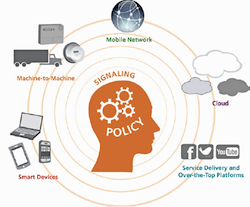At the Policy Control and Data Pricing Conference in Berlin on Wednesday, both Amdocs and Tekelec showcased new policy management solutions designed to help operators deal with two key issues around Wi-Fi – offload and monetisation.
First, Amdocs unveiled its Wi-Fi Experience Solution, which allows operators to extend existing data services with Wi-Fi, provided they already have existing infrastructure that supports Hotspot 2.0.
“If an operator has an existing Wi-Fi deployment and is looking to link that Wi-Fi network into their existing mobile network, these are scenarios we are able to support without the need for new infrastructure,” explained Shannon Bell, Director of Revenue Enablement, Data Experience Business Unit, Amdocs.
Besides offering authentication to support Wi-Fi offload, Amdocs wants operators to be able to monetise Wi-Fi and create new offerings through the use of the Access Network Discovery and Selection Function (ANDSF) standard.
ANDSF enables analytics to be gathered by the core network and the subscriber’s handset about where the subscriber is and how the network is performing, and then the network and device make intelligent decisions about where to offload types of traffic and how to calculate billing.
The Wi-Fi Experience Solution sits in the control plane of the core network, providing the access, authentication, off-load and the signalling for off-load, as well as subscriber management and policy rules.
“The solution is integrated into the BSS and the existing payment mechanisms that the operator has, and then provides interfaces down to the network through integration with the wireless gateways,” Bell told Mobile Europe.
Intelligent Wi-Fi is Phase Two
But getting the right infrastructure and deploying a Wi-Fi network successfully with the mobile network is only “Phase One”, according to Bell.
“When we get to Phase Two of Wi-Fi and offload deployments, that’s when operators are looking for more intelligent offload solution, which is why we have the ANDSF standard and devices communicating with the network and making more intelligent policy decisions. That’s where we felt there’s a real need for a more complete Wi-Fi solution.”
Chris Nicolls, principal analyst at Analysys Mason agrees with this assessment.
“MNOs are not interested in just dumping traffic from a cell to Wi-Fi, if it is at the expense of the user experience. What Amdocs, Tekelec and others are doing is beefing up the ability of Wi-Fi to be more than just a ‘best-effort’ solution and instead be a viable adjunct to cellular service, or for fixed operators a viable extension to the home experience,” he said (Read MWC 2013: Carrier-grade Wi-Fi using Passpoint won’t be available till 2014).
The monetisation use cases that Amdocs feels would be most attractive to operators include the ability to offer a premium or roaming Wi-Fi service whereby a subscriber is automatically transferred to the partner operator’s Wi-Fi network while abroad, and the billing system is able to count the Wi-Fi usage towards the roaming quota package offered.
Another idea is to offer a shared Wi-Fi wallet that enables multiple devices to share the same amount of quota on Wi-Fi, using the portal to connect onto the same subscriber plan.

The various uses of policy management used in Tekelec’s Mobile Policy Gateway
Going beyond ANDSF
Second, Tekelec has unveiled a policy management solution that deals with Wi-Fi backhaul management, but their product, the Mobile Policy Gateway, aims to differentiate itself by enabling a wider range of use cases to improve operators’ networks and offer capex and opex savings, rather than focusing just on monetisation.
“What we’re doing with our policy solution is making it really flexible,” said Mark Ventimiglia, director of strategy and innovation at Tekelec.
“We want to expand the ANDSF model and make it more dynamic. We build our policy solution from the ground up so that we can take into account the real-time information that we get from the network.
“ANDSF doesn’t have access to the customer information, but our system does and can also look at the types of traffic and treat it differently, such as information from OTT providers and websites telling us that we need to increase the bandwidth for the subscriber.”
According to Tekelec, this information is always dynamic and real-time, provided at the press of a button.
“It’s good to see Amdocs working with ANDSF and not trying to reinvent that wheel, and Tekelec working on optimisation features. The next revolution in wireless is not going to be some breakthrough in radio or spectrum, it will be in the more intelligent use of spectrum and bandwidth,” added Nicoll.
In terms of the Wi-Fi offload and the intelligent decision-making process, which can be sent over the air to devices, Amdocs and Tekelec’s solutions are quite similar.
In addition, both companies said that while their products can be used standalone, user input would be needed, whereas if the products were used together with relevant server products from Amdocs and Tekelec, the two systems together would be able to perform a lot of the intelligent decision-making automatically without input.
However, Tekelec’s solution is also meant to deal with a whole host of problems affecting operators that can be solved using policy rule management.
“Our new white paper concentrates on use cases for policies to the mobile gateway in particular, but you could sit down and brainstorm literally thousands of use cases, revenue generators or operability,” said Ventimiglia.
“Our goal is to provide the flexibility to make that happen. Revenue is obviously very important, but it’s not the only thing our customers demand from us.”
Acoording to Nicoll, many operators, whether they currently offer Wi-Fi or not, are still trying to figure out how the technology fits into their service model.
“I believe it has a strong role to play for fixed, mobile and integrated operators, but it’s not a slam-dunk. Just stringing up access points everywhere does not ensure success. Wi-Fi is no longer the poor cousin to cellular services, it’s the brother.”
Read more: Panasonic Avionics promotes airplane Wi-Fi with first mid-air Tweetathon



